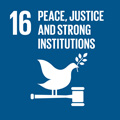- Docente: Marco Borraccetti
- Credits: 8
- SSD: IUS/14
- Language: Italian
- Moduli: Marco Borraccetti (Modulo 1) Marco Borraccetti (Modulo 2) (Modulo 3)
- Teaching Mode: In-person learning (entirely or partially) (Modulo 1); In-person learning (entirely or partially) (Modulo 2); In-person learning (entirely or partially) (Modulo 3)
- Campus: Forli
- Corso: Second cycle degree programme (LM) in International Relations and Diplomatic Affairs (cod. 9247)
Learning outcomes
Aim of the course is to give a general knowledge of the development of EU Migration Law in the recent years; at the end students will be able to analyze the legal framework in a critical way.
Course contents
Module Jean Monnet "The EU Immigration Law"
The course concerns the Law of the EU on immigration; particular attention will be paid to the rules governing the entry into the European Union and the free movement of non-EU citizens within the EU territory, underscoring the differences that may exist between Member States that are part of the Schengen Area and those that are not. The course will also cover the rules on the free movement of EU citizens and, therefore, as inherent to it, on the citizenship of the Union.
An introductory part will cover the historical evolution of the EU policy on immigration; it will also analyze different aspects that are influencing the migratory phenomenon in a global perspective.
During the lessons it will be taken into consideration the various documents produced by the Commission, the Council and the European Parliament, as well as the case-law of the Court of Justice.
The course will be divided into six parts.
Section I: General Introduction to the EU Policy on Immigration
Relevant disposition of the EU Treaties and of the Charter of Fundamental Rights; the history of the EU Immigration Policy; the legal framework; the international agreements in the field of immigration.
Section II: The Free Movement of EU Citizens
The free movement of EU citizens; who is a citizen?; transitories dispositions for the new Member States.
Section III: The Institutional Framework of the European Immigration Policy
The roles of the Commission, Council and European Parliament in the field of immigration: the legal basis of their actions. The role of the Court of Justice in the interpretation and in the development of the EU Immigration Law
Section IV: How to enter the EU and how to freely move on its territory?
The Control of external borders and the European Visa Policy; reception policies vs refusal of entry policies. The return directive. The legal framework on immigrant's reception; the question of the exploitation of irregular immigrants; the access to employment; the freedom of movement for non-EU citizens.
Section V: Migration and European Neighbourhood Policies
Immigration Policy and Neighbourhood Countries (NC); Migration, agreements with NC and the conditionality clause.
Section VI: The Implications of Human Rights for Immigration
The immigration policy and the respect of fundamental and human rights. The Member States responsibility; the immigration and the conditionality clause.
Readings/Bibliography
Calamia, Gestri, Di Filippo, Immigrazione Diritto e Diritti: profili internazionalistici ed europei, Padova, 2012; Nascimbene, Lo straniero nel diritto internazionale, Milano, 2013;
Amadeo, Spitaleri, Il diritto dell'immigrazione e dell'asilo dell'Unione europea, Giappichelli, 2020.
Teaching methods
The course is based on frontal lectures; it will be highly interactive and time will be divided to debates following the specific topics dealth with in class
Assessment methods
The course is based on frontal lectures; it will be highly interactive and time will be divided to debates following the specific topics dealth with in class.
Assessment methods
Evaluation is based on an oral exam (for attenders only)(50%) which will take place at the end of the course and on a position paper (50%).
The programme will be the same for attenders and non attenders
Teaching tools
Power Point; web.
Office hours
See the website of Marco Borraccetti
See the website of
SDGs




This teaching activity contributes to the achievement of the Sustainable Development Goals of the UN 2030 Agenda.
